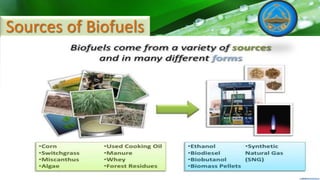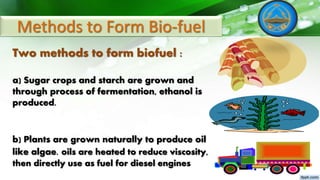Biofuelcomplete
- 3. Aim To apprise you about the biofuels and its perspective for the future generation
- 4. Scope What is Fuel? Why there is Energy Crisis Sources of Energy What is Biofuels? Sources of Biofuels Categories of Biofuels Production of Biofuels Advantages of Biofuel
- 5. FUEL • Fuels are required for a variety of purposes, but are utilized chiefly for.. • Fuels are any materials that store potential energy in forms that can be practicably released and used as heat energy
- 6. Transportation Globally, transportation require 25% of energy demand and nearly 62% of oil is already consumed from world account
- 7. Power Generation The generation of electricity is the single largest use of fuel in the world. More than 60 % of electric power are generated from fossil fuels.
- 8. Power Crisis Two hundred years ago, the world experienced an energy revolution that launched the Industrial Age. After two hundreds years, the industrialized world's thirst for energy had increased tremendously, that causes a serious energy crisis.
- 9. 35% 24% 21% 11% 7% 2% 1% Oil Coal Natural gas Renewable source Nuclear Hydro Other sources World Energy Consumption
- 10. World Energy Consumption Graph
- 11. Fossil Fuels will soon be Exhausted
- 12. If we had replenish fuel sources, what direction should we go in? • Electric cars • Solar power • Wind power OR BUT BIOFUELS
- 14. Non-renewable • Oil • Natural gas • Coal Renewable • Solar energy • Hydro power • Biofuel • Biomass • Tidal energy • Wind energy • Geothermal • Nuclear energy Renewable and non- renewable energy
- 16. A biofuel is a type of fuel whose energy is derived from biological carbon fixation. In other words, Fuel which produced from renewable biological resources such as plant biomass and treated municipal and industrial waste. What is Bio-fuel?
- 17. Why Bio-fuel?
- 18. Therefore, there are many reasons why we are interested in biofuels: • To reduce our dependence on fossil fuels. • To reduce reliance on foreign oil. • To lower emissions of greenhouse gases. • To bring business to rural economics. Why Bio-fuel?
- 20. They can be divided into three categories • Made from sugar, starch, and vegetable oil. First generation Bio-fuel • Made from non-edible plant materials. Second generation Biofuel • Made from algae and microbes. Third generation Bio-fuel Categories of Bio fuels
- 22. Two methods to form biofuel : a) Sugar crops and starch are grown and through process of fermentation, ethanol is produced. b) Plants are grown naturally to produce oil like algae. oils are heated to reduce viscosity, then directly use as fuel for diesel engines Methods to Form Bio-fuel
- 25. Bio-diesel
- 26. Palm seeds Coconut seeds Rapeseeds Jatropha seeds Sunflower seeds Corn Soybean seeds Pond Algae Bio-diesel feed stock Algae Corn Rapeseed/ Mustard seed Coconut Palm Animal fats Soybean
- 27. Inputs: – Fat/Vegetable Oil (“Feedstock”) – Methanol/Ethanol – Catalyst - “Lye” (Sodium Hydroxide or Potassium Hydroxide) – Water Outputs: – Biodiesel – Dirty Water – Glycerine Bio-diesel
- 28. • Biodiesel is a famous biofuel in Europe • Produced from oils or fats using trans-esterification after mixing the biomass with methanol and sodium hydroxide. • methanol and sodium hyrox • Produced after mixing the biomass with methanol and sodium hyroxide • Used for car diesel engi PrProduced after mixing the biomass with methanol and sodium hyroxide ♫ Used for car diesel engines oduced after mixing the biomass with methanol and sodium hyroxide ♫ Used for car diesel engines Bio-diesel
- 31. • Biodiesel can be termed clean fuel as it does not contain carcinogens and its sulphur content is also lesser than the mineral diesel. • It possesses high biodegradability and lubricating property • Improves engine efficiency and operating life cycle. • Domestic resource • Readily mixes with petroleum diesel fuel in any ratio • Higher flash point makes it safer in transport and storage • Greatly reduces particulate matter and carbon monoxide emissions Advantages of Biodiesel
- 32. Higher production cost. Biodiesel is more likely than petroleum diesel to attract moisture. Poor low temperature properties. Disadvantages of biodiesel
- 33. BIOALCOHOL
- 34. Bioalcohols Biologically produced alcohols, most commonly ethanol, and less commonly propanol and butanol. Synthesis: Bioalcohols are produced by the action of microorganisms and enzymes through the fermentation of sugars or starches (easiest), or cellulose (which is more difficult). Production of Bio-ethanol
- 35. Petrol engines as a replacement for gasoline Fireplaces Fuel for vehicles Ethanol fuel is the most commonly used bio-fuel in the world and particularly in Brazil Application of Bio-ethanol
- 36. • Generally used for cooking purpose. • It is used in several old diesel engines that have indirect injection systems. • Vegetable oil is mainly used for the production of biodiesel. Vegetable Oil
- 37. Bio-Gas
- 38. Bio-Gas • To produce Electricity • Cooking purpose • to heat the digester • space heating • water heating
- 40. Production of Algae fuel
- 42. Production of Algae fuel
- 43. Advantages of Algae fuel
- 44. Advantages of Bio-fuel Environmental Aspect Locally available in every region of the world. There is no emission of hazardous gases Friendly with the environment, so they do not cause global warming The energy release per unit mass of biofuel is greater than the energy released from the unit mass of fossil fuels.
- 45. Job creation Improving agriculture Socio-Economic Aspect Rural electrification Power to Local community















































